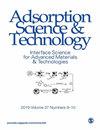ZnO、TiO2和Al2O3对水中Pb(II)的吸附:过程研究、吸附行为和热力学
IF 3.2
4区 工程技术
Q2 CHEMISTRY, APPLIED
引用次数: 9
摘要
本研究旨在比较氧化锌(ZnO)、二氧化钛(TiO2)和氧化铝(Al2O3)通过吸附去除水中铅离子的用途。ZnO、TiO2和Al2O3的零电荷点分别为7.3、7.1和9.0。在分批实验中研究了pH、吸附剂剂量、接触时间、初始浓度和温度的影响。得到的最佳条件为7 g/L,120 分钟,100 ppm和41°C,其中ZnO、TiO2和Al2O3的最佳去除率分别为98.43%、96.45%和85.50%。此外,还对吸附动力学、机理、等温线和热力学进行了分析。将Pb(II)的吸附动力学与常用的模型进行了比较,发现伪二阶(PSO)模型在相关系数(R2≥0.96)下最适合所有吸附剂对Pb(Ⅱ)的吸收。将Pb(II)的吸附等温线与常用模型进行了比较,发现TiO2和ZnO对Pb(Ⅱ)的吸附符合Langmuir模型(R2≥0.96),最大吸附容量分别为55.04和58.88 mg/g。另一方面,用Dubinin-Radushkevich(D-R)模型(R2=0.96)更准确地描述了Al2O3的行为,其最大吸附容量为53.64 毫克/克。等温线分析证明,吸附过程的极限步骤是膜扩散机制。此外,对Pb(II)吸附热的研究表明,由于所有吸附剂的焓值为正值(ΔH°≥30),吸附是吸热的。使用扫描电子显微镜(SEM)和能量色散X射线光谱(EDX)对吸收剂进行表征,以研究表面形态和吸附剂的化学表征,以确保实现吸附。ZnO对铅的吸收表现出更好的性能,其次是TiO2,然后是Al2O3。本文章由计算机程序翻译,如有差异,请以英文原文为准。
Adsorption of Pb(II) from Water onto ZnO, TiO2, and Al2O3: Process Study, Adsorption Behaviour, and Thermodynamics
This study is aimed at comparing the use of zinc oxide (ZnO), titanium dioxide (TiO2), and aluminium oxide (Al2O3) for removing lead ions from water through adsorption. The point of zero charge was obtained for ZnO, TiO2, and Al2O3 and was found to be 7.3, 7.1, and 9.0, respectively. The effect of pH, adsorbent dose, contact time, initial concentrations, and temperature was investigated in batch experiments. The optimal conditions obtained were 7, 2 g/L, 120 mins, 100 ppm, and 41°C, respectively, where the optimal removal efficiencies were 98.43%, 96.45%, and 85.50% for ZnO, TiO2, and Al2O3, respectively. In addition, analyses of adsorption kinetics, mechanisms, isotherms, and thermodynamics were performed. The adsorption kinetics of Pb(II) were compared to popular models, and it was found that the pseudo-second-order (PSO) model best fitted the Pb(II) uptake for all adsorbents at correlation coefficient (
R
2
≥
0.96
). The adsorption isotherms of Pb(II) were also compared to popular models, and it was found that the Pb(II) uptake by TiO2 and ZnO was well-described by the Langmuir model (
R
2
≥
0.96
) with maximum adsorption capacities of 55.04 and 58.88 mg/g, respectively. On the other hand, the behaviour of Al2O3 is described more accurately by the Dubinin-Radushkevich (D-R) model (
R
2
=
0.96
), and the maximum adsorption capacity was 53.64 mg/g. The isotherm analysis proved that the limiting step of the adsorption process is the film diffusion mechanism. In addition, studying the heat of adsorption of Pb(II) implied that the adsorption is endothermic due to the positive values of enthalpy (
Δ
H
°
≥
30
) for all adsorbents. The absorbents were characterized using scanning electron microscopy (SEM) and energy-dispersive X-ray spectroscopy (EDX) to study the morphology of surfaces and the chemical characterization of the adsorbents to ensure that adsorption is achieved. ZnO showed better performance for the uptake of lead followed by TiO2 then Al2O3.
求助全文
通过发布文献求助,成功后即可免费获取论文全文。
去求助
来源期刊

Adsorption Science & Technology
工程技术-工程:化工
CiteScore
5.00
自引率
10.30%
发文量
181
审稿时长
4.5 months
期刊介绍:
Adsorption Science & Technology is a peer-reviewed, open access journal devoted to studies of adsorption and desorption phenomena, which publishes original research papers and critical review articles, with occasional special issues relating to particular topics and symposia.
 求助内容:
求助内容: 应助结果提醒方式:
应助结果提醒方式:


